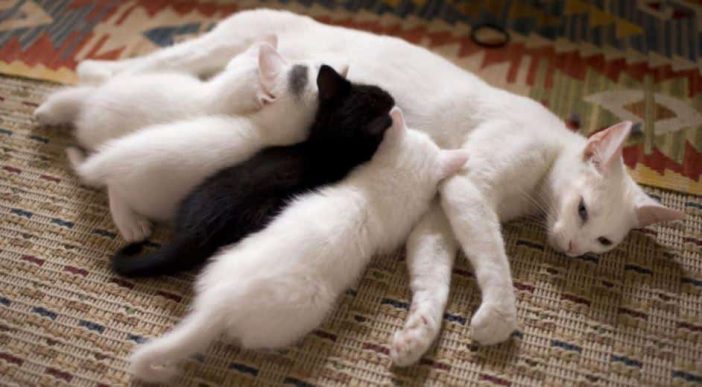Eclampsia in cats, also known as puerperal tetany or milk fever is a life-threatening condition that requires emergency treatment. It results in a drop in blood calcium level or hypocalcemia commonly noted in lactating cats and occurs weeks after birth (mostly after 1-4 weeks).
On rare occasions, it can also be noted before birth, especially in late pregnancy, and it requires the immediate attention of your veterinarian.
Whereas kittens may not be affected so much, this condition will make them not to meet their nutritional requirements.
In terms of prevalence, although any queen may be affected, this condition is commonly noted during the first litters and in large litters.
Causes
The exact reason why feline eclampsia occurs is not well understood. However, it is associated with the following causes.

- Inappropriate diets with inadequate amounts of calcium and vitamin D, especially vitamin D3 or calcitriol. According to Veterinary Partner.vin.com, “calcitriol acts to enhance calcium absorption into the body from the intestine, promote its release from bone, and cause the kidney to avoid dumping” this mineral.
- Any gastrointestinal disorders that affect normal digestion or absorption of the various nutrients given to these pets.
- Excessive calcium loss by queens during lactation, which surpasses the rate at which it is being replenished. This may result in “tonoclonic contractions of the skeletal muscles,” notes pet MD.com
- Calcium supplementation during pregnancy
- Hypoparathyroidism in cats characterized by low parathyroid hormone production that may be due to several reasons.
Symptoms
Since milk fever is only a cause of hypocalcemia, some of the noted symptoms will resemble those of hypocalcemia in cats and they include:
- Neuromuscular symptoms including restlessness, nervousness, muscle tremors, convolutions, tetany (moving stiffly), a stiff gait, disorientation, pupil dilation, lying with paws stretched out stiffly for a long time, panting, heavy breathing, and so on.
- Negative mothering behavior
- Temperature rise
- Diarrhea and vomiting
- Whining
Diagnosis
Your vet will require to know more about this pet’s history including when the symptoms began, any dietary supplements, and diet.
This will be followed by a complete blood count (CBC), blood biochemistry profile, electrolyte panel, and an electrocardiogram.
Serum calcium concentration below 7 mg/dL will indicate a deficiency. There may also be abnormal heartbeats, low magnesium, and blood sugar.
Treatment
Eclampsia requires emergency treatment with intravenous injection of calcium gluconate done slowly for about 10 minutes and the use of a fan or cold soak in case of fever to cool the queen down.
Furthermore, your vet may recommend hand feeding kittens with a milk replacer until their mother stabilizes and your vet gives you a go-ahead after determining your cat has the required levels of ionized calcium and it can maintain it.
Your vet may recommend anti-seizure medications such as diazepam and dextrose to raise blood sugar.
Also, oral calcium supplementation may help. However, before you consider supplementing this mineral, seek your vet’s advice. Some of the excellent supplements to buy include Pet-Tabs Calcium Formula Supplement, Vitality Science Lithothamnium Calcium Supplement for Cats & Dogs, Johnson’s veterinary calcium tablets for cats & dogs, Tums among others.
Prevention
If your kittens begin nursing, it will be a good idea to consider calcium supplements until they are weaned but avoid supplementation during pregnancy unless your veterinary recommends so since it can suppress parathyroid hormone and hence hypocalcemia.
Ensure your cat’s diet has enough amount of calcium and in the required ratio with phosphorous, especially before and during gestation. Go for premium quality commercial foods and avoid cottage cheese (its low in phosphorous).
Finally, avoid any food that hampers calcium absorption. Also, and make sure diets have vitamin D in its required amounts. However, don’t over-supplementation.
